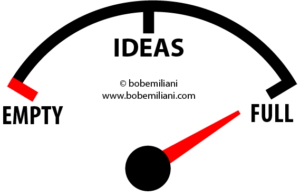“Every organization constantly deteriorates. And this is especially true of a business organization. It loses customers — through death, through change in location, through the lures of competitors. It loses its personnel from the same causes. Its physical equipment is constantly wearing out and becoming obsolete… It is the primary function of management to rebuild at a rate that exceeds these losses. Management can never rest. If it does, the organization deteriorates. It must attract new customers. It must provide for trained replacement in advance of necessity. It must study new inventions, new devices and better methods. It must initiate a flow of experiments.” – Oswald Knauth, “The Dilemma of Management,” Advanced Management Quarterly Journal, Volume X, No. 1, January-March 1945
 A recent article in The Economist said: “Weak growth in productivity has economists asking whether humanity is running out of ideas…” How does one run out of ideas, whether as an individual, a group, an organisation such as business, or even humanity? Ideas generally come from direct and indirect associations that people make in relation to the problem at-hand. The associations are made by interacting with various types of information sources (art, books, news media, academic research papers, etc.), as well as human social interaction.
A recent article in The Economist said: “Weak growth in productivity has economists asking whether humanity is running out of ideas…” How does one run out of ideas, whether as an individual, a group, an organisation such as business, or even humanity? Ideas generally come from direct and indirect associations that people make in relation to the problem at-hand. The associations are made by interacting with various types of information sources (art, books, news media, academic research papers, etc.), as well as human social interaction.
When business becomes dehumanized, as it has in recent decades (via layoffs, outsourcing, offshoring, and other forms of human replacement), social interaction among employees and between management and employees is reduced. Specifically, information is deliberately withheld; information that could help form associations that would solve the problems at-hand. Withholding information is a tactic designed to preserve one’s employment or position within an organization. The effect of reduced social interaction is to reduce organizational social and technical intelligence. This, in turn, makes problem-solving more difficult, which contributes to the observed low productivity growth. But there is more to it than this.
Economic Component: Business leaders adhere to 18th century economic ideas in the 21st century, and thus discount contemporary knowledge and facts. Economic ideas that made sense in the handicraft era, and informed by animism, lose relevance in the post-modern corporate industrial and digital eras.
Social Component: Organizations are hierarchical, where leaders typically see themselves as superior to workers in all ways beyond mere rank. Superiority, whether implied by rank or made explicit by shows of force, reduces social interaction and the flow of associations necessary for generating ideas to experiment with.
Political Component: Leaders believe they must exhibit power and control over employees. When actualized, this has the effect of choking off ideas and thus cutting off the flow of experimentation needed to “rebuild at a rate that exceeds these losses.”
Historical Component: The past is ever-present. What worked well yesteryear is carried forward, in whole or part, by prior generations of managers and thoughtlessly applied to today and tomorrow. Hierarchies, social, and political pressures in organizations make it very difficult for anyone to safely ask: “Why do we do it that way?” The easier and smoother path is to accept rather than reject.
Philosophical Component: Business philosophy is rooted in old and ancient economic, social, and political constructs. These are transferred from one generation of managers to the next via a personal learning process — exposure early in one’s career to veteran managers.
Ideas run out when people, particularly leaders, remain firmly attachment to the large array of preconceptions associated with each of these five components. Leaders have ideas, but the ideas are almost always within a narrow range of long-established preconceptions and which result in a perpetuation of the status quo. Most followers dutifully do just as their leaders do, and so they assimilate the interconnected web of preconceptions without question. This social inheritance process, always reflective of the past and therefore outdated, is virtually self-perpetuating and results in the constant avoidance of systemic change.
Ideas never run dry when preconceptions are challenged. This is the greatest lesson of Toyota’s kaizen mindset and method. As Mr. Knauth said: “Every organization constantly deteriorates… [management] must initiate a flow of experiments.” You need ideas to run experiments, and ideas are generated by questioning the status quo and related preconceptions.
The Economist article also said: “Economists tend to treat wage growth as a function of technological progress…” Economists should break free of that preconception and consider wage growth (or stagnation/reduction) more as a function of social progress (or decline).
For more information about how leader’s preconceptions limit employee ideation and experimentation, see Moving Forward Faster, The Triumph of Classical Management Over Lean Management, and the Supplement to Triumph of Classical Management.
